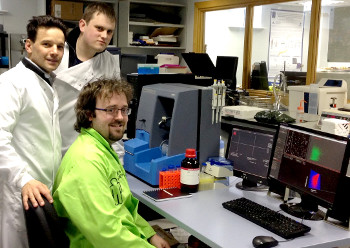Apr 9 2013
NanoSight reports on how Nanoparticle Tracking Analysis, NTA, is being applied in the development of future diagnostic and theranostic solutions for early diagnosis, drug delivery and treatment of cancer at the School of Medicine and CRANN, Trinity College Dublin, Ireland.
The School of Medicine (Institute of Molecular Medicine) and CRANN (the Centre for Research on Adaptive Nanostructures and Nanodevices) are based at Trinity College Dublin (TCD) where researchers work in developing new knowledge of nanoscale materials, with a particular focus on new device and sensor technologies, biotechnology and medical technology sectors, with a growing interest in multifunctional materials.
 Adriele Prina-Mello, Kieran Staunton and Ciaran Maguire (members of the Nanomedicine group, Trinity College Dublin) with NanoSight's NS500 system.
Adriele Prina-Mello, Kieran Staunton and Ciaran Maguire (members of the Nanomedicine group, Trinity College Dublin) with NanoSight's NS500 system.
Dr Adriele Prina-Mello is a Research Fellow at CRANN and a part-time lecturer at the School of Medicine, Trinity College Dublin. His research focuses on functional biomaterials, diagnostic devices, and multifunctional nanomaterials for theranostic solutions in the treatment of cancer. Fundamental in this work is the understanding of particle size, size distribution and of hydrodynamic response of nanoparticles dependent on their degree of aggregation. Additionally, being able to measure zeta potential and track particle behavior in viscous or physiologically relevant media, informs the increasing characterization demands of the nanomedicine community. Here pressure is on tools providers to offer the most comprehensive and low volume testing of sometimes very "expensive" samples.
Dr Prina-Mello describes the Nanomedicine team goals: "Our main motivation for such levels of characterization is determined by the potential use, applicability, and safety aspect linked to nanosize materials. This allows for further modification of the particle surface coating/moieties in order to get closer to the suitable candidate for diagnostic, monitoring and therapeutic application for nanomedicine and or biomedical research and also clinical translation. Furthermore, we also need characterization information as basic preliminary understanding, in order to address wider experimental screening based on pharmaceutical standards, necessary to identify potential nanoparticle as lead carrier candidates for drug delivery of therapeutics".
Continuing, he notes the benefits of using NanoSight's NTA instrumentation in complement to other characterization techniques: "NanoSight allows for the identification of heterogeneity in particle size, poly-dispersity and counting with simultaneous zeta potential measurement. Furthermore, the use of small sample volumes compared to other techniques allows for cost effective, daily and routine characterization."
To find out about the company and to learn more about particle characterization using NanoSight's unique nanoparticle tracking analysis solutions, visit the NanoSight website and register to receive the next issue of NanoTrail, the company's electronic newsletter.